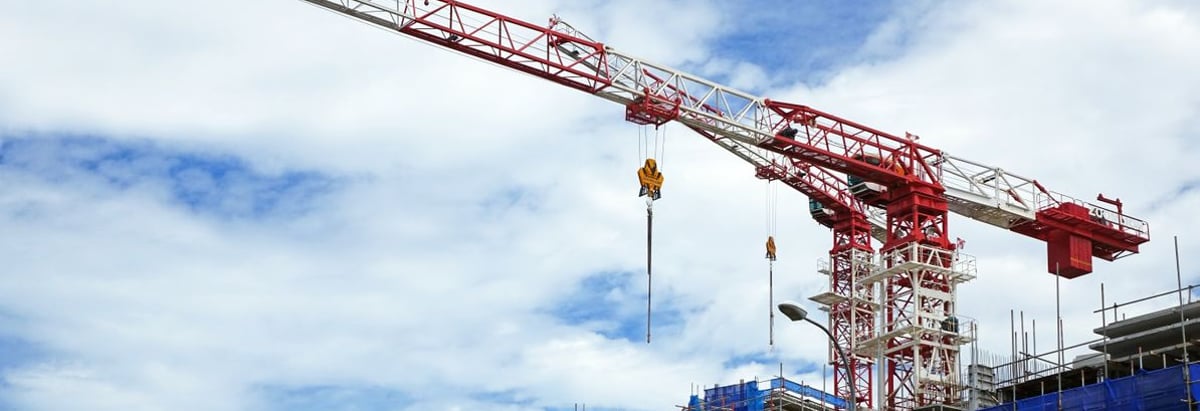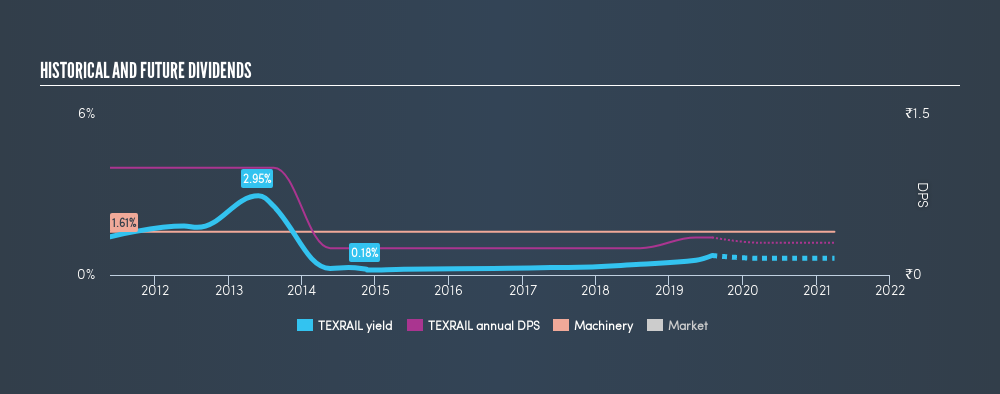Why Texmaco Rail & Engineering Limited (NSE:TEXRAIL) Is A Top Dividend Stock

Dividend paying stocks like Texmaco Rail & Engineering Limited (NSE:TEXRAIL) tend to be popular with investors, and for good reason - some research suggests a significant amount of all stock market returns come from reinvested dividends. Yet sometimes, investors buy a popular dividend stock because of its yield, and then lose money if the company's dividend doesn't live up to expectations.
Investors might not know much about Texmaco Rail & Engineering's dividend prospects, even though it has been paying dividends for the last eight years and offers a 0.7% yield. A 0.7% yield is not inspiring, but the longer payment history has some appeal. When buying stocks for their dividends, you should always run through the checks below, to see if the dividend looks sustainable.
Explore this interactive chart for our latest analysis on Texmaco Rail & Engineering!

Payout ratios
Dividends are usually paid out of company earnings. If a company is paying more than it earns, then the dividend might become unsustainable - hardly an ideal situation. As a result, we should always investigate whether a company can afford its dividend, measured as a percentage of a company's net income after tax. Looking at the data, we can see that 10% of Texmaco Rail & Engineering's profits were paid out as dividends in the last 12 months. With a low payout ratio, it looks like the dividend is comprehensively covered by earnings.
Is Texmaco Rail & Engineering's Balance Sheet Risky?
As Texmaco Rail & Engineering has a meaningful amount of debt, we need to check its balance sheet to see if the company might have debt risks. A quick check of its financial situation can be done with two ratios: net debt divided by EBITDA (earnings before interest, tax, depreciation and amortisation), and net interest cover. Net debt to EBITDA measures total debt load relative to company earnings (lower = less debt), while net interest cover measures the ability to pay interest on the debt (higher = greater ability to pay interest costs). Texmaco Rail & Engineering has net debt of 2.76 times its EBITDA. Using debt can accelerate business growth, but also increases the risks.
Net interest cover can be calculated by dividing earnings before interest and tax (EBIT) by the company's net interest expense. With EBIT of 2.00 times its interest expense, Texmaco Rail & Engineering's interest cover is starting to look a bit thin.
Dividend Volatility
From the perspective of an income investor who wants to earn dividends for many years, there is not much point buying a stock if its dividend is regularly cut or is not reliable. Looking at the last decade of data, we can see that Texmaco Rail & Engineering paid its first dividend at least eight years ago. It's good to see that Texmaco Rail & Engineering has been paying a dividend for a number of years. However, the dividend has been cut at least once in the past, and we're concerned that what has been cut once, could be cut again. During the past eight-year period, the first annual payment was ₹1.00 in 2011, compared to ₹0.35 last year. This works out to a decline of approximately 65% over that time.
A shrinking dividend over a eight-year period is not ideal, and we'd be concerned about investing in a dividend stock that lacks a solid record of growing dividends per share.
Dividend Growth Potential
With a relatively unstable dividend, and a poor history of shrinking dividends, it's even more important to see if EPS are growing. It's good to see Texmaco Rail & Engineering has been growing its earnings per share at 30% a year over the past 5 years. The company is only paying out a fraction of its earnings as dividends, and in the past been able to use the retained earnings to grow its profits rapidly - an ideal combination.
Conclusion
Dividend investors should always want to know if a) a company's dividends are affordable, b) if there is a track record of consistent payments, and c) if the dividend is capable of growing. It's great to see that Texmaco Rail & Engineering is paying out a low percentage of its earnings and cash flow. Second, earnings per share have been essentially flat, and its history of dividend payments is chequered - having cut its dividend at least once in the past. All things considered, Texmaco Rail & Engineering looks like a strong prospect. At the right valuation, it could be something special.
See if management have their own wealth at stake, by checking insider shareholdings in Texmaco Rail & Engineering stock.
We have also put together a list of global stocks with a market capitalisation above $1bn and yielding more 3%.
We aim to bring you long-term focused research analysis driven by fundamental data. Note that our analysis may not factor in the latest price-sensitive company announcements or qualitative material.
If you spot an error that warrants correction, please contact the editor at editorial-team@simplywallst.com. This article by Simply Wall St is general in nature. It does not constitute a recommendation to buy or sell any stock, and does not take account of your objectives, or your financial situation. Simply Wall St has no position in the stocks mentioned. Thank you for reading.
About NSEI:TEXRAIL
Texmaco Rail & Engineering
Manufactures, sells, and provides services for rail and rail related products in India and internationally.
Solid track record with excellent balance sheet.
Similar Companies
Market Insights
Community Narratives




